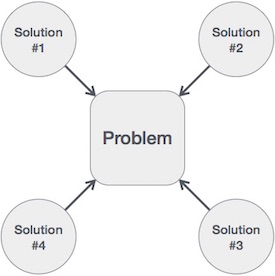Hi everyone, inside this article we will see the concept about Concept of Algorithm Analysis.
An algorithm in data structure refers to a set of instructions or steps that are designed to solve a specific problem or perform a particular task using data structures.
It is a sequence of computational steps that transform the input into the desired output. The goal of an algorithm in data structure is to provide an efficient and effective solution to a given problem, with the use of data structures that are appropriate to the problem being solved.
Characteristics of an Algorithm
An algorithm can be defined as a set of instructions or rules that provide a step-by-step approach to solve a particular problem or perform a specific task.
The following are the characteristics of an algorithm:
- Unambiguous: An algorithm should be clear and precise, with unambiguous instructions that leave no room for interpretation. The instructions should be well-defined and easy to understand.
- Well-defined inputs and outputs: An algorithm should take well-defined inputs and produce well-defined outputs. The inputs and outputs should be clearly specified, and the algorithm should be designed to handle any valid input.
- Finiteness: An algorithm should have a finite number of steps, meaning that it should eventually terminate after a finite number of iterations.
- Deterministic: An algorithm should be deterministic, meaning that given the same input, it should produce the same output every time it is executed. It should not have any random or unpredictable behavior.
- Feasibility: An algorithm should be feasible, meaning that it should be possible to execute it in a reasonable amount of time and with a reasonable amount of memory.
- Language-independent: An algorithm should be independent of any particular programming language or implementation. It should be possible to describe the algorithm in a natural language or pseudocode that can be translated into any programming language.
- Correctness: An algorithm should produce the correct output for all valid inputs. It should be verified and tested to ensure that it produces the expected results under all conditions.
Overall, an algorithm should provide a systematic and structured approach to solving a problem or performing a task, with clear inputs and outputs, unambiguous instructions, and a finite number of steps.
What is Algorithm Analysis?
Algorithm analysis is the process of evaluating the performance of an algorithm in terms of its running time and space complexity. In other words, it involves determining how much time and memory an algorithm requires to solve a given problem.
The goal of algorithm analysis is to help us understand the behavior of an algorithm so that we can make informed decisions about when to use it and how to optimize its performance. It is also an essential step in designing and developing new algorithms.
There are several factors that can affect the performance of an algorithm, including the size of the input, the hardware on which the algorithm is run, and the specific details of the algorithm itself. To analyze an algorithm, we typically focus on its worst-case running time and space complexity, which provides an upper bound on the amount of time and memory the algorithm will require for any input of a given size.
There are several techniques that we can use to analyze the running time and space complexity of an algorithm, including:
- Asymptotic analysis (Time and space complexity): This involves analyzing the behavior of an algorithm as the input size approaches infinity. Asymptotic analysis provides a useful way to compare the performance of different algorithms and identify the fastest-growing terms in their running time and space complexity.
- Big-O notation: This is a mathematical notation that is used to describe the upper bound on the running time and space complexity of an algorithm. It allows us to express the behavior of an algorithm in terms of a simple function that characterizes its growth rate.
- Empirical analysis: This involves running an algorithm on a specific input and measuring its running time and memory usage. Empirical analysis can provide useful insights into the behavior of an algorithm on real-world data, but it is limited by the specific input used for testing.
By analyzing the performance of an algorithm, we can identify opportunities to optimize its running time and space complexity. This may involve refining the algorithm itself or using data structures that are more efficient for a given problem. Ultimately, algorithm analysis is an essential tool for designing and developing high-performance algorithms that can solve complex problems quickly and efficiently.
How to write an Algorithm?
Here are the steps to follow when writing an algorithm in data structure:
- Define the problem: Clearly define the problem that the algorithm is meant to solve. Identify the inputs, the desired outputs, and any constraints that need to be considered.
- Choose a method: Choose the appropriate method for solving the problem. This could involve selecting a particular data structure or a specific algorithmic technique.
- Create a plan: Break down the problem into smaller sub-problems and create a plan to solve each sub-problem. Consider different approaches and select the most efficient one.
- Write the pseudocode: Write the algorithm in pseudocode, a high-level description of the algorithm that is language-independent. Pseudocode should use simple, human-readable language that describes the steps of the algorithm in a clear and concise manner.
- Test the algorithm: Test the algorithm to make sure it is correct and efficient. Use test cases to ensure that the algorithm produces the expected outputs for a range of inputs.
- Optimize the algorithm: Identify any bottlenecks or inefficiencies in the algorithm and make changes to optimize its performance. This could involve tweaking the data structure, adjusting the algorithmic technique, or reorganizing the plan.
- Write the code: Once the algorithm has been fully developed, write the code in the chosen programming language. Make sure the code adheres to the principles and structure of the pseudocode.
- Test the code: Test the code thoroughly to ensure that it produces the desired results and that it is free from errors.
By following these steps, you can create an effective algorithm that is optimized for solving the specific problem at hand.
We design an algorithm to get a solution of a given problem. A problem can be solved in more than one ways.

Stages of Algorithm Analysis
There are typically three stages of algorithm analysis in data structure and algorithms:
- Worst-case analysis: This stage involves analyzing the algorithm’s performance when it is given the worst possible input. In other words, it examines how the algorithm performs when the input data is the most difficult to process. This helps to identify the maximum amount of time and resources required for the algorithm to complete the task.
- Average-case analysis: This stage involves analyzing the algorithm’s performance when it is given a representative or typical input. This helps to identify the average amount of time and resources required for the algorithm to complete the task.
- Best-case analysis: This stage involves analyzing the algorithm’s performance when it is given the best possible input. This helps to identify the minimum amount of time and resources required for the algorithm to complete the task.
By performing these three stages of analysis, we can gain a better understanding of the algorithm’s performance and efficiency, and identify any potential issues or areas for improvement. This allows us to optimize the algorithm and ensure that it is both effective and efficient in solving the problem at hand.
Algorithm analysis is an essential component of data structure and algorithm design. By analyzing the time and space complexity of an algorithm, we can determine its efficiency and scalability, and identify areas for improvement. In practice, algorithm analysis is used to evaluate and compare different algorithms for solving a given problem, and to optimize the performance of existing algorithms.
We hope this article helped you to understand about Concept of Algorithm Analysis in a very detailed way.
Online Web Tutor invites you to try Skillshike! Learn CakePHP, Laravel, CodeIgniter, Node Js, MySQL, Authentication, RESTful Web Services, etc into a depth level. Master the Coding Skills to Become an Expert in PHP Web Development. So, Search your favourite course and enroll now.
If you liked this article, then please subscribe to our YouTube Channel for PHP & it’s framework, WordPress, Node Js video tutorials. You can also find us on Twitter and Facebook.
